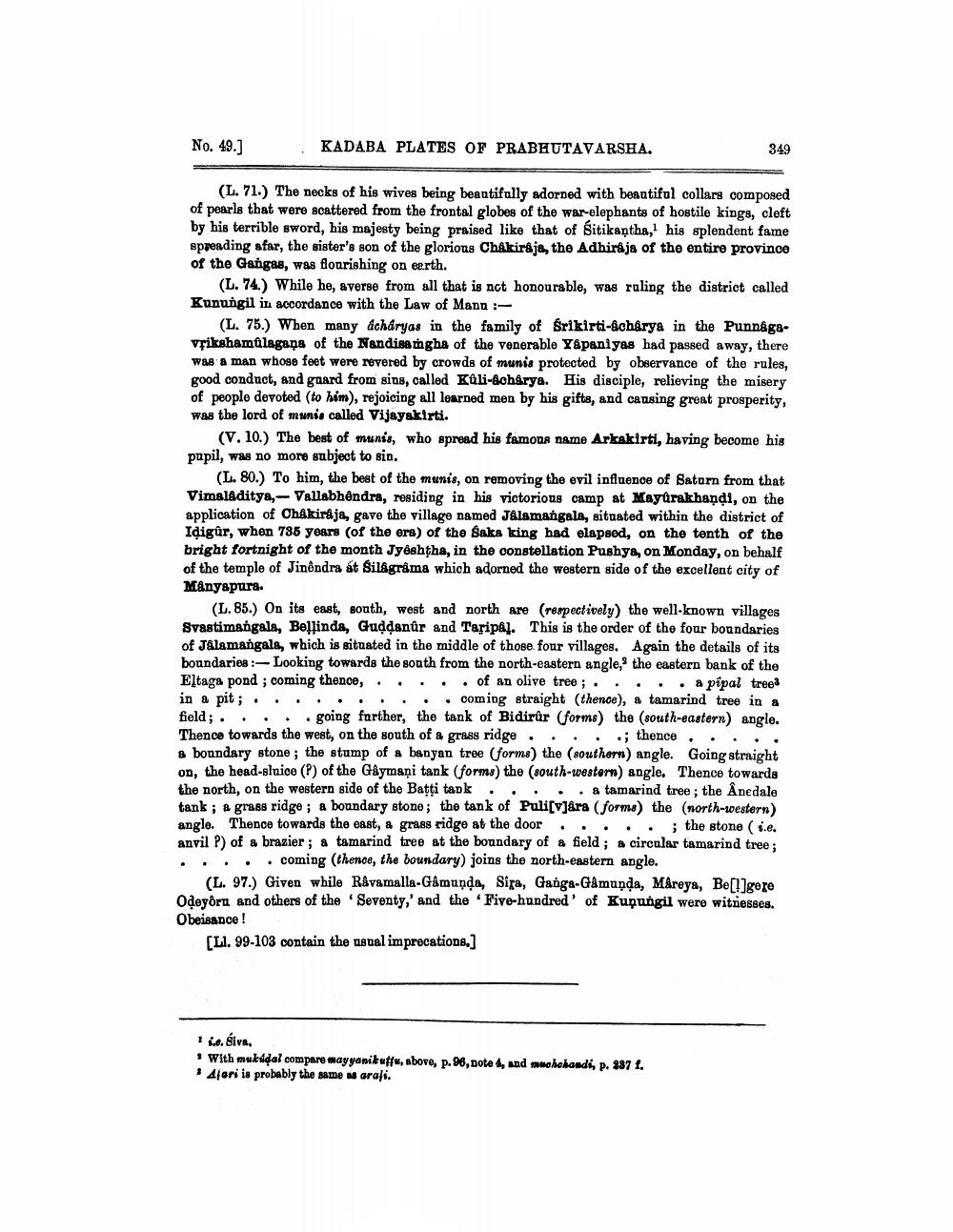________________
No. 49.]
KADABA PLATES OF PRABHUTAVARSHA.
349
(L. 71.) The necks of his wives being beautifully adorned with beautiful collarg composed of pearls that were scattered from the frontal globes of the war-elephants of hostile kings, cleft by his terrible sword, his majesty being praised like that of Sitikantha, his splendent fame spreading sfar, the sister's son of the glorions Châkirkja, the Adhiraja of the entire province of the Gangas, was flourishing on eerth.
(L. 74.) While he, averse from all that is not honourable, was ruling the district called Kunungil in accordance with the Law of Mann :
(L. 75.) When many doharyas in the family of Srikirti-acharya in the Punnagavfikshamtlagana of the Nandisamgha of the venerable Yapaniyas had passed away, there was a man whose feet were revered by crowds of munis protected by observance of the rules, good conduct, and guard from sins, called Kali-écharya. His disciple, relieving the misery of people devoted to him), rejoicing all learned men by his gifts, and causing great prosperity, was the lord of munis called Vijayakirti.
(V. 10.) The best of munis, who spread his famona name Arkakirti, having become his papil, was no more subject to sin.
(L. 80.) To him, the best of the munis, on removing the evil influence of Saturn from that Vimaladitya,- Vallabhôndra, residing in his victorious camp at Mayurakhandi, on the application of Chakirkja, gave the village named JAlamangala, situated within the district of Idigûr, when 735 years (of the ora) of the Saks king bad elapsed, on the tenth of the bright fortnight of the month Jyêshtha, in the constellation Pushya, on Monday, on behalf of the temple of Jinêndra át Silågråms which adorned the western side of the excellent city of Mânyapura.
(L. 85.) On its east, south, west and north are respectively) the well-known villages Svastimangala, Bellinda, Guddanúr and Taripal. This is the order of the four boundaries of Jalamangala, which is situated in the middle of those four villages. Again the details of its boundaries :- Looking towards the south from the north-eastern angle, the eastern bank of the Eltaga pond ; coming thence, . . . .. of an olive treo ; . . . . . a pípal trees in a pit; . . . . .. .. . . coming straight (thence), a tamarind tree in a field;. . . going farther, the tank of Bidirûr (forms) the (south-eastern) angle. Thence towards the west, on the south of a grass ridge . . . . .; thence, . . .. 8 boundary stone; the stump of a banyan tree (forms) the (southern) angle. Going straight on, the head-sluice (R) of the Gdymaņi tank (forms) the (south-westor) angle. Thence towards the north, on the western side of the Baţti tank . .. a tamarind tree; the Ânedale tank; a grass ridge ; a boundary stone; the tank of Puli[vjára (forms) the (north-western) angle. Thence towards the east, & grass ridge at the door . . . . . ; the stone (s.e. anvil ?) of a brazier ; a tamarind tree at the boundary of a field; a circular tamarind tree; . ... .coming (thenoe, the boundary) joins the north-eastern angle.
(L. 97.) Given while Ravamalla-Gámunda, Sira, Ganga-Gåmanda, Mareys, Berligere Odeyðru and others of the Seventy,' and the 'Five-hundred' of Kuņungil were witnesses. Obeisance !
[LI. 99-103 contain the usual imprecations.]
1 Lc. sive, With muddal compare mayyanikut, above, p.06, note 4, and wholandi, p. 987 1. Alari is probably the same m arali.




